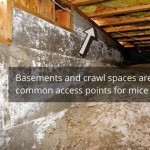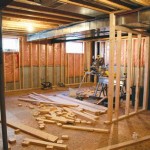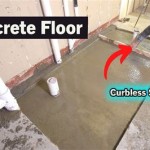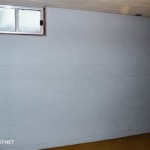Installing Insulation in Your Basement Ceiling: A Comprehensive Guide
Basement insulation is a critical element in maintaining a comfortable and energy-efficient home. A significant amount of heat can be lost through an uninsulated basement ceiling, leading to higher energy bills and uncomfortable living spaces. Properly insulating this area can greatly reduce heat loss in the winter and help keep the house cooler in the summer. This article provides a comprehensive guide to installing insulation in a basement ceiling, covering the benefits, different types of insulation, tools required, steps involved, and important safety considerations.
Understanding the Benefits of Basement Ceiling Insulation
Insulating a basement ceiling offers numerous benefits that extend beyond simple temperature regulation. These benefits include:
Enhanced Energy Efficiency: A primary benefit is the significant reduction in energy consumption. Insulation acts as a barrier against heat transfer, preventing heat from escaping during colder months and keeping unwanted heat out during warmer months. This leads to reduced reliance on heating and cooling systems, resulting in lower energy bills.
Improved Comfort: Insulation helps create a more consistent and comfortable indoor environment. By minimizing drafts and temperature fluctuations, the overall comfort level of the home is significantly improved.
Noise Reduction: Basement ceilings are often directly beneath living areas. Insulation provides soundproofing qualities, reducing noise transmission between the basement and the floors above. This is particularly useful in multi-story homes or in situations where the basement is used as a recreation or entertainment space.
Moisture Control: While insulation itself doesn't directly prevent moisture problems, it contributes to a more stable indoor environment, reducing condensation and the potential for mold growth. It is essential to address any existing moisture issues before installing insulation.
Increased Home Value: Properly insulated homes are more attractive to potential buyers. Basement insulation is a valuable improvement that can increase a home's overall value and marketability.
Choosing the Right Type of Insulation
Selecting the appropriate type of insulation is vital for achieving optimal performance. Several options are available, each with its own advantages and disadvantages. Common types of insulation for basement ceilings include:
Fiberglass Batt Insulation: Fiberglass batts are a widely used and cost-effective option. They are relatively easy to install and come in various thicknesses and R-values (a measure of thermal resistance). Fiberglass batts are suitable for standard joist spacing but require careful installation to avoid gaps or compression, which can reduce their effectiveness. Installation typically requires a vapor barrier, depending on the climate.
Rigid Foam Insulation: Rigid foam boards, such as expanded polystyrene (EPS), extruded polystyrene (XPS), and polyisocyanurate, offer high R-values and are resistant to moisture. They are often used in direct contact with basement walls or ceilings. For basement ceiling applications, rigid foam can be cut to fit between joists or attached directly to the ceiling using adhesive and mechanical fasteners. Rigid foam requires careful sealing of seams and edges to prevent air leaks and should be covered with a fire-rated material like drywall.
Spray Foam Insulation: Spray foam is a highly effective insulation option that creates an airtight seal, filling gaps and cracks that other types of insulation may miss. There are two main types of spray foam: open-cell and closed-cell. Closed-cell spray foam has a higher R-value and is more resistant to moisture, making it an excellent choice for basements. Open-cell spray foam is less expensive but has a lower R-value and is less resistant to moisture. Spray foam insulation typically requires professional installation.
Mineral Wool Insulation: Mineral wool, also known as rock wool or slag wool, is a fire-resistant and sound-absorbing insulation option. It is available in batts or loose-fill form. Mineral wool batts are installed similarly to fiberglass batts, and loose-fill mineral wool can be blown into cavities. Mineral wool is more expensive than fiberglass but offers superior fire resistance and soundproofing qualities.
When choosing insulation, it's important to consider the local climate, budget, and desired R-value. Consulting with a professional insulation contractor can help determine the best option for a particular situation.
Essential Tools and Materials
Before commencing the insulation project, it is essential to gather all the necessary tools and materials. This ensures a smooth and efficient installation process.
Insulation Material: The selected type of insulation in the required quantity, based on the area of the basement ceiling.
Safety Gear:
- Safety glasses or goggles for eye protection.
- Dust mask or respirator to prevent inhaling insulation fibers.
- Gloves to protect hands from irritation.
- Long-sleeved shirt and pants to cover skin.
Cutting Tools:
- Utility knife or insulation knife for cutting fiberglass batts or mineral wool.
- Saw or knife for cutting rigid foam boards.
Measuring Tools:
- Measuring tape to determine the dimensions of the ceiling and joist spacing.
- Straight edge or level to ensure accurate cuts and installations.
Fastening Tools:
- Staple gun and staples for securing fiberglass batts or mineral wool.
- Construction adhesive for attaching rigid foam boards.
- Screws or nails for extra support, if needed.
Sealing Materials:
- Caulk or sealant to seal gaps and cracks around the perimeter of the ceiling and penetrations.
- Foil tape to seal seams between rigid foam boards.
Additional Tools:
- Ladder or scaffolding for reaching high areas of the ceiling.
- Flashlight or work light for illuminating dark areas.
- Dustpan and brush for cleaning up debris.
Step-by-Step Installation Guide
The following steps provide a detailed guide to installing insulation in a basement ceiling. It's important to adapt these steps based on the specific type of insulation being used.
Step 1: Preparation
- Clear the basement floor and remove any obstacles that may hinder access to the ceiling.
- Inspect the basement ceiling for any signs of moisture or leaks. Address any water problems before installing insulation.
- Clean the ceiling surface to remove dust, debris, and cobwebs.
- Measure the distance between the joists to determine the appropriate width of the insulation.
Step 2: Cutting the Insulation
- For fiberglass batts or mineral wool, measure and cut the insulation to fit snugly between the joists. Add a few inches to the length to allow for compression and ensure a tight fit.
- For rigid foam boards, measure and cut the boards to fit between the joists or cover the entire ceiling surface. Use a sharp knife or saw and make precise cuts to minimize gaps.
Step 3: Installing the Insulation
- Fiberglass Batts or Mineral Wool: Place the insulation batts between the joists, ensuring they fit snugly and without compression. The vapor barrier (if present) should face the heated area (up towards the floor above). Use a staple gun to secure the insulation to the sides of the joists, spacing the staples every few inches.
- Rigid Foam Boards: Apply construction adhesive to the back of the rigid foam boards and press them firmly against the ceiling. For additional support, use screws or nails to secure the boards to the joists. Ensure that the boards are tightly fitted together, leaving minimal gaps.
- Spray Foam Insulation: This option should be installed by a professional. The spray foam is applied directly to the ceiling surface, filling all gaps and cracks.
Step 4: Sealing Gaps and Cracks
- Use caulk or sealant to seal any gaps or cracks around the perimeter of the ceiling, where it meets the walls.
- Seal any penetrations, such as pipes or wiring, with caulk or sealant to prevent air leaks.
- For rigid foam boards, use foil tape to seal the seams between the boards, creating an airtight barrier.
Step 5: Covering Insulation (If Necessary)
- Depending on local building codes and personal preferences, it may be necessary to cover the insulation with a fire-rated material, such as drywall.
- This is especially important for rigid foam insulation, which is combustible and requires a thermal barrier.
- Install drywall according to standard practices, ensuring a smooth and professional finish.
Safety Precautions
Safety is paramount when working with insulation. Always adhere to the following safety precautions to minimize risks.
Wear Protective Gear: Always wear safety glasses or goggles, a dust mask or respirator, and gloves when handling insulation materials. This protects the eyes, respiratory system, and skin from irritation and potential health hazards.
Ventilation: Ensure adequate ventilation in the basement during installation. Open windows or use a fan to circulate air and reduce the concentration of airborne fibers.
Avoid Compression: Do not compress fiberglass batts or mineral wool insulation, as this reduces their R-value and effectiveness. Install the insulation snugly but without excessive force.
Electrical Safety: Be cautious when working around electrical wiring. Turn off the power to the area before working near wires or outlets. If unsure, consult a qualified electrician.
Handling Insulation: Follow the manufacturer's instructions for handling and disposal of insulation materials. Some insulation products may require special handling procedures.
Ladder Safety: Use a sturdy ladder and follow proper ladder safety practices. Ensure the ladder is placed on a stable surface and that someone is available to spot if necessary.

Should I Insulate My Basement Ceiling And Walls Aire Serv

Best Insulation For Soundproofing Your Ceiling Renoviso

What Is Basement Ceiling Insulation And It Worth

Best Insulation For Basement Ceilings And Why You Need It

Basement Ceiling Insulation Interior Inspections Internachi Forum

How To Cover Insulation In Basement Ceiling Barrier Energy

What To Know About Soundproofing A Basement Ceiling

How To Soundproof A Basement Ceiling

Basement Insulation Upstate Spray Foam

How To Complete A Diy Basement Walls And Ceiling Insulation Project







